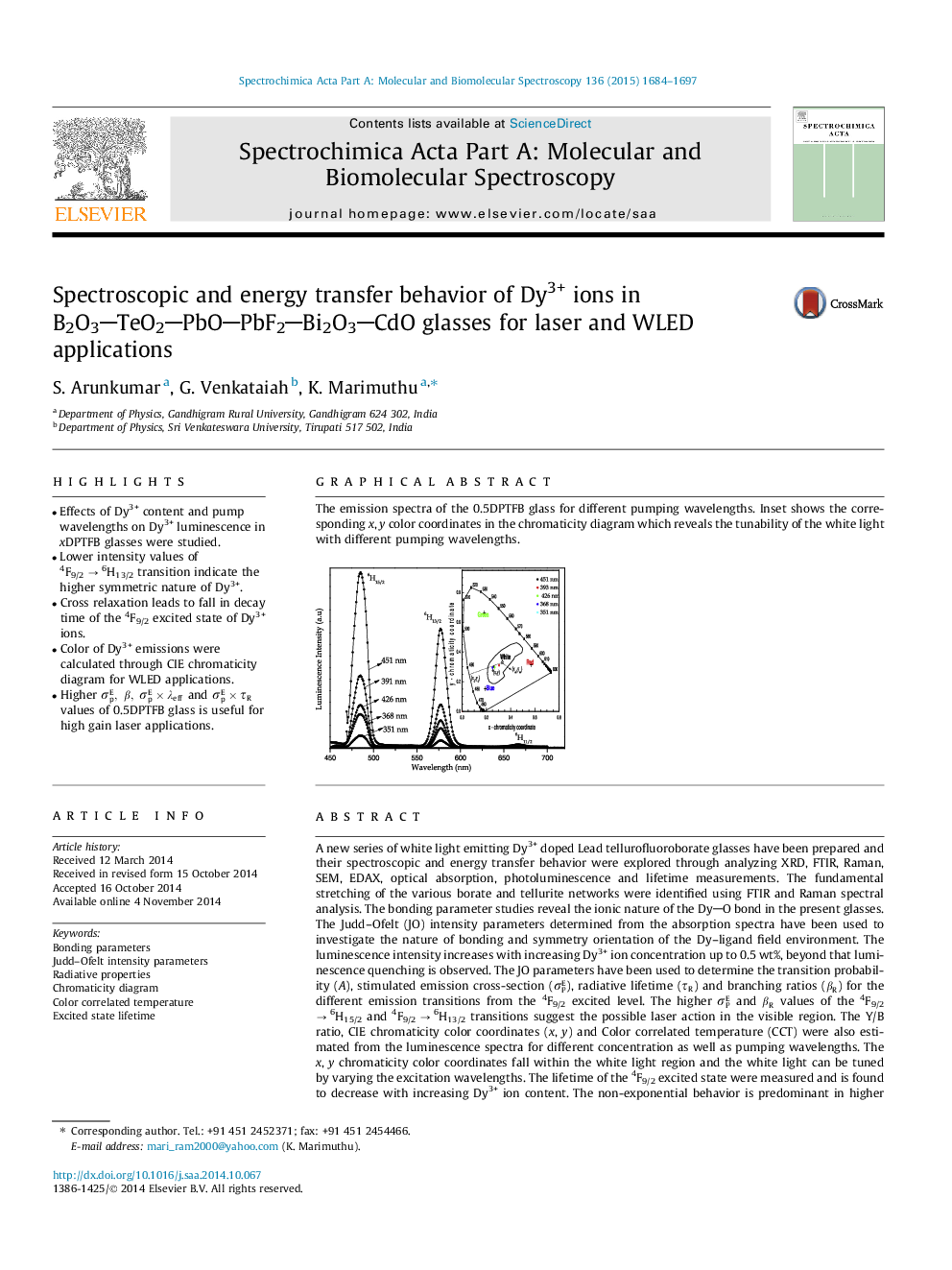| کد مقاله | کد نشریه | سال انتشار | مقاله انگلیسی | نسخه تمام متن |
|---|---|---|---|---|
| 1232483 | 968792 | 2015 | 14 صفحه PDF | دانلود رایگان |

• Effects of Dy3+ content and pump wavelengths on Dy3+ luminescence in xDPTFB glasses were studied.
• Lower intensity values of 4F9/2 → 6H13/2 transition indicate the higher symmetric nature of Dy3+.
• Cross relaxation leads to fall in decay time of the 4F9/2 excited state of Dy3+ ions.
• Color of Dy3+ emissions were calculated through CIE chromaticity diagram for WLED applications.
• Higher σpE,β,σpE×λeffandσpE×τR values of 0.5DPTFB glass is useful for high gain laser applications.
A new series of white light emitting Dy3+ doped Lead tellurofluoroborate glasses have been prepared and their spectroscopic and energy transfer behavior were explored through analyzing XRD, FTIR, Raman, SEM, EDAX, optical absorption, photoluminescence and lifetime measurements. The fundamental stretching of the various borate and tellurite networks were identified using FTIR and Raman spectral analysis. The bonding parameter studies reveal the ionic nature of the DyO bond in the present glasses. The Judd–Ofelt (JO) intensity parameters determined from the absorption spectra have been used to investigate the nature of bonding and symmetry orientation of the Dy–ligand field environment. The luminescence intensity increases with increasing Dy3+ ion concentration up to 0.5 wt%, beyond that luminescence quenching is observed. The JO parameters have been used to determine the transition probability (A ), stimulated emission cross-section (σPE), radiative lifetime (τRτR) and branching ratios (βRβR) for the different emission transitions from the 4F9/2 excited level. The higher σPE and βRβR values of the 4F9/2 → 6H15/2 and 4F9/2 → 6H13/2 transitions suggest the possible laser action in the visible region. The Y/B ratio, CIE chromaticity color coordinates (x, y) and Color correlated temperature (CCT) were also estimated from the luminescence spectra for different concentration as well as pumping wavelengths. The x, y chromaticity color coordinates fall within the white light region and the white light can be tuned by varying the excitation wavelengths. The lifetime of the 4F9/2 excited state were measured and is found to decrease with increasing Dy3+ ion content. The non-exponential behavior is predominant in higher Dy3+ ion content glasses and is due to the efficient energy transfer between Dy3+Dy3+ ions. The decay curves were fitted to the Inokuti–Hirayama (IH) model to understand the nature of energy transfer. Among the prepared glasses, 0.5DPTFB glass possesses higher A,βR,σPE,η values and is suggested for lasers and WLED applications.
The emission spectra of the 0.5DPTFB glass for different pumping wavelengths. Inset shows the corresponding x, y color coordinates in the chromaticity diagram which reveals the tunability of the white light with different pumping wavelengths.Figure optionsDownload as PowerPoint slide
Journal: Spectrochimica Acta Part A: Molecular and Biomolecular Spectroscopy - Volume 136, Part C, 5 February 2015, Pages 1684–1697